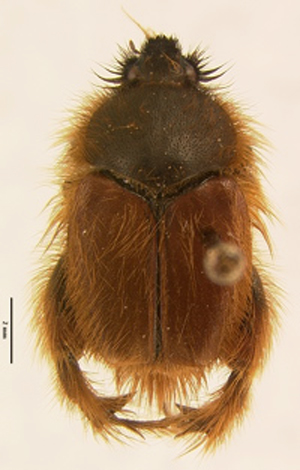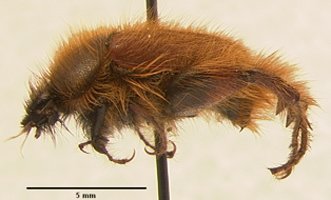..
.
.
.
.
.
.
.
.
.
Classification |
.......Arctodium
vulpinum (Erichson, 1835)
.......Syn. Cratoscelis
vulpina Erichson, 1835
.......Syn. Cratoscelis aterrima Blanchard, 1850
.......Syn. Cratoscelis gayana Blanchard, 1850
.......Syn. Cratoscelis villosa Blanchard, 1850
.......Syn. Cratoscelis striolata Redtenbacher, 1868
|

|
 |
Arctodium
vulpinum (Erichson).
Photo by Mary Liz Jameson. |
| |
|
Distribution of Arctodium
vulpinum. |
| |
|
|
|
| |
| |
| |
| |
| |
| |
| |
| |
| |
| |
| |
| |
| |
| |
| |
| |
| |
| |
| |
| |
| |
| |
| |
| |
| |
| |
| |
| |
| |
| |
| |
| |
| |
| |
| |
| |
Description. Arctodium vulpinum is the most
widespread and common species in the tribe Lichniini. It has a broad
range of variation in morphological characters that make it a difficult
species to diagnose. Arctodium vulpinum is, on average, the
largest species of Lichniini, with males 8.0–12.0 mm long and
females 8.5–11.7 mm long. Because there is some overlap in size
(smaller specimens of A. vulpinum are as small as the largest
specimens of A. discolor or A. planum), the best
way to distinguish small specimens is by ruling out characters defining
other species: A. vulpinum does not have a pale fringe of
setae along the eye canthus as in A. planum, it does not have
black setae on the legs and wide elytra giving it a square-like body
form as in A. discolor, or it is not less than 6.5 mm long
as in A. mahdii.
|
| |
| |
| |
| |
| |
| |
| |
| |
| |
| |
| |
| |
Remarks. In Blanchard’s (1850)
description of Cratoscelis aterrima, he differentiated the species
from others in the genus on the basis of the black color on all parts
of the body. However, this species is based on a black color morph found
in females of A. vulpinum. Aside from its black color, C.
aterrima shares all other characters with A. vulpinum and
observations of the more common brown morph males mating with black female
morphs on flowers were noted in Cajon del Maipo, Chile (Hawkins 2006).
In collections, series of A. vulpinum contain approximately
one female black morph out of every eight female specimens collected.
Although black color morphs have not been named as a subspecies in any
publication, many collections have specimens labeled as C. vulpina
aterrima. Because the black morphs do not constitute an isolated
subdivision of A. vulpinum but rather are found throughout the
populations as a phenotypic variant, they should not be considered a
subspecies.
|
| |
| |
| |
| |
| |
| |
| |
| |
| |
| |
| |
| |
| |
| |
| |
Distribution. Widespread
in Central Chile from Region IV (Coquimbo) to Region IX (La Araucania).
|
| |
|
Phenology. October through February with most known
specimens being collected in late November or early December.
|
| |
| |
References:
Blanchard, C.É. (1850). Ordre des Coléoptères,
pp. 51–62. In, Milne-Edwards, H., C. É. Blanchard,
and H. Lucas (eds.), Museum d’Histoire Naturelle de Paris.
Catalogue de la Collection Entomologique. Classe des Insectes,
Ordre des Coléoptères. Vol. 1, Part 1, Gide & Baudry,
Paris, 128 pp.
Hawkins, S. J. 2006. Revision of the Chilean tribe Lichniini Burmeister,
1844 (Coleoptera: Scarabaeidae: Melolonthinae). Zootaxa 1266: 1-63.
|
| |
| |
| |
| |
| |
| |
| |
| |
| |
|
|
|
|
Author: Shauna
Joy Hawkins
Generated on: 26/APR/2007.....
Last modified: 26/APR/2007
University of Nebraska State Museum - Division of Entomology
|
|

